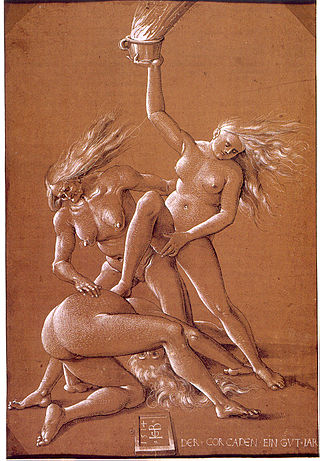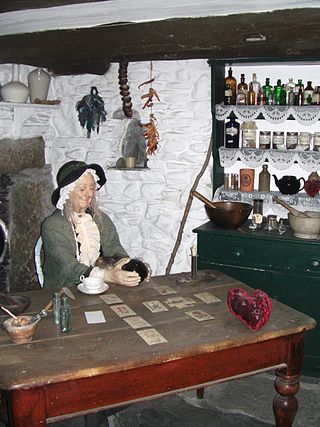Witchcraft, as most commonly understood in both historical and present-day communities, is the use of alleged supernatural powers of magic. A witch is a practitioner of witchcraft. Traditionally, "witchcraft" means the use of magic or supernatural powers to inflict harm or misfortune on others, and this remains the most common and widespread meaning. According to Encyclopedia Britannica, "Witchcraft thus defined exists more in the imagination of contemporaries than in any objective reality. Yet this stereotype has a long history and has constituted for many cultures a viable explanation of evil in the world". The belief in witchcraft has been found in a great number of societies worldwide. Anthropologists have applied the English term "witchcraft" to similar beliefs in occult practices in many different cultures, and societies that have adopted the English language have often internalised the term.

A witch-hunt, or a witch purge, is a search for people who have been labeled witches or a search for evidence of witchcraft. Practicing evil spells or incantations was proscribed and punishable in early human civilizations in the Middle East. In medieval Europe, witch-hunts often arose in connection to charges of heresy from Christianity. An intensive period of witch-hunts occurring in Early Modern Europe and to a smaller extent Colonial America, took place about 1450 to 1750, spanning the upheavals of the Counter Reformation and the Thirty Years' War, resulting in an estimated 35,000 to 50,000 executions. The last executions of people convicted as witches in Europe took place in the 18th century. In other regions, like Africa and Asia, contemporary witch-hunts have been reported from sub-Saharan Africa and Papua New Guinea, and official legislation against witchcraft is still found in Saudi Arabia and Cameroon today.

Traditional healers of Southern Africa are practitioners of traditional African medicine in Southern Africa. They fulfill different social and political roles in the community like divination, healing physical, emotional, and spiritual illnesses, directing birth or death rituals, finding lost cattle, protecting warriors, counteracting witchcraft and narrating the history, cosmology, and concepts of their tradition.

A witch doctor was originally a type of healer who treated ailments believed to be caused by witchcraft. The term is now more commonly used to refer to healers, particularly in regions which use traditional healing rather than contemporary medicine.

Summis desiderantes affectibus, sometimes abbreviated to Summis desiderantes, was a papal bull regarding witchcraft issued by Pope Innocent VIII on 5 December 1484.

Witchcraft has been present throughout the Philippines even before Spanish colonization, and is associated with indigenous Philippine folk religions. Its practice involves black magic, specifically a malevolent use of sympathetic magic. Today, practices are said to be centered in Siquijor, Cebu, Davao, Talalora, Western Samar, and Sorsogon, where many of the country's faith healers reside. Witchcraft also exists in many of the hinterlands, especially in Samar and Leyte; however, witchcraft is known and occurs anywhere in the country.

Filipino shamans, commonly known as babaylan, were shamans of the various ethnic groups of the pre-colonial Philippine islands. These shamans specialized in communicating, appeasing, or harnessing the spirits of the dead and the spirits of nature. They were almost always women or feminized men. They were believed to have spirit guides, by which they could contact and interact with the spirits and deities and the spirit world. Their primary role were as mediums during pag-anito séance rituals. There were also various subtypes of babaylan specializing in the arts of healing and herbalism, divination, and sorcery.

European witchcraft is a multifaceted historical and cultural phenomenon that unfolded over centuries, leaving a mark on the continent's social, religious, and legal landscapes. The roots of European witchcraft trace back to classical antiquity when concepts of magic and religion were closely related, and society closely integrated magic and supernatural beliefs. Ancient Rome, then a pagan society, had laws against harmful magic. In the Middle Ages, accusations of heresy and devil worship grew more prevalent. By the early modern period, major witch hunts began to take place, partly fueled by religious tensions, societal anxieties, and economic upheaval. Witches were often viewed as dangerous sorceresses or sorcerers in a pact with the Devil, capable of causing harm through black magic. A feminist interpretation of the witch trials is that misogynist views of women led to the association of women and malevolent witchcraft.
In Navajo culture, a skin-walker is a type of harmful witch who has the ability to turn into, possess, or disguise themselves as an animal. The term is never used for healers.

Witch, from the Old English wiċċe, is a term rooted in European folklore and superstition for a practitioner of witchcraft, magic or sorcery. Traditionally associated with malevolent magic, with those accused of witchcraft being the target of witch-hunts, in the modern era the term has taken on different meanings. In literature, a 'witch' can now simply refer to an alluring women capable of 'bewitching' others. In neopagan religions such as Wicca the term has meanwhile been adopted as the female term for an adherent.
In June 2007 the Office of the Premier of the Mpumalanga province in South Africa leaked a draft Mpumalanga Witchcraft Suppression Bill of 2007.

A nganga is a spiritual healer, diviner, and ritual specialist in traditional Kongo religion. These experts also exist across the African diaspora in countries where Kongo and Mbundu people were transported during the Atlantic slave trade, such as Brazil, the southern United States, Haiti and Cuba.

Christianity is the predominant religion in the Democratic Republic of the Congo, with Catholicism and Protestantism being its main denominations.

Traditional African medicine is a range of traditional medicine disciplines involving indigenous herbalism and African spirituality, typically including diviners, midwives, and herbalists. Practitioners of traditional African medicine claim, largely without evidence, to be able to cure a variety of diverse conditions including cancer, psychiatric disorders, high blood pressure, cholera, most venereal diseases, epilepsy, asthma, eczema, fever, anxiety, depression, benign prostatic hyperplasia, urinary tract infections, gout, and healing of wounds and burns and Ebola.

Cunning folk, also known as folk healers or wise folk, were practitioners of folk medicine, helpful folk magic and divination in Europe from the Middle Ages until the 20th century. Their practices were known as the cunning craft. Their services also included thwarting witchcraft. Although some cunning folk were denounced as witches themselves, they made up a minority of those accused, and the common people generally made a distinction between the two. The name 'cunning folk' originally referred to folk-healers and magic-workers in Britain, but the name is now applied as an umbrella term for similar people in other parts of Europe.

The Witchcraft Suppression Act 3 of 1957 is an act of the Parliament of South Africa that prohibits various activities related to witchcraft, witch smelling or witch-hunting. It is based on the Witchcraft Suppression Act 1895 of the Cape Colony, which was in turn based on the Witchcraft Act 1735 of Great Britain.

African divination is divination practiced by cultures of Africa.

Witchcraft among the Zande people of North Central Africa is magic used to inflict harm on an individual that is native to the Azande tribal peoples. The belief in witchcraft is present in every aspect of Zande society. They believe it is a power that can only be passed on from a parent to their child. To the Azande, a witch uses witchcraft when he has hatred towards another person. Witchcraft can also manipulate nature to bring harm upon the victim of the witch. Oracles and witch doctors determine whether someone is guilty of using witchcraft on another villager. More magic is then created to avenge the victim and punish the one who committed the transgression.

Beatrix Leslie was a Scottish midwife executed for witchcraft. In 1661 she was accused of causing the collapse of a coal pit through witchcraft. Little is known about her life before that, although there are reported disputes with neighbours that allude to a quarrelsome attitude.
Witchcraft is deeply rooted in many African countries and communities in Sub-Saharan Africa. It has been specifically relevant to Ghana's culture, beliefs, and lifestyle. It continues to shape lives daily and with that it has promoted tradition, fear, violence, and spiritual beliefs. The perceptions on witchcraft change from region to region within Ghana, as well as in other countries in Africa. The commonality is that it is not something to take lightly, and the word spreads fast if there are rumors' surrounding civilians practicing it. The actions taken by local citizens and the government towards witchcraft and violence related to it have also varied within regions in Ghana. Traditional African religions have depicted the universe as a multitude of spirits that are able to be used for good or evil through religion.













